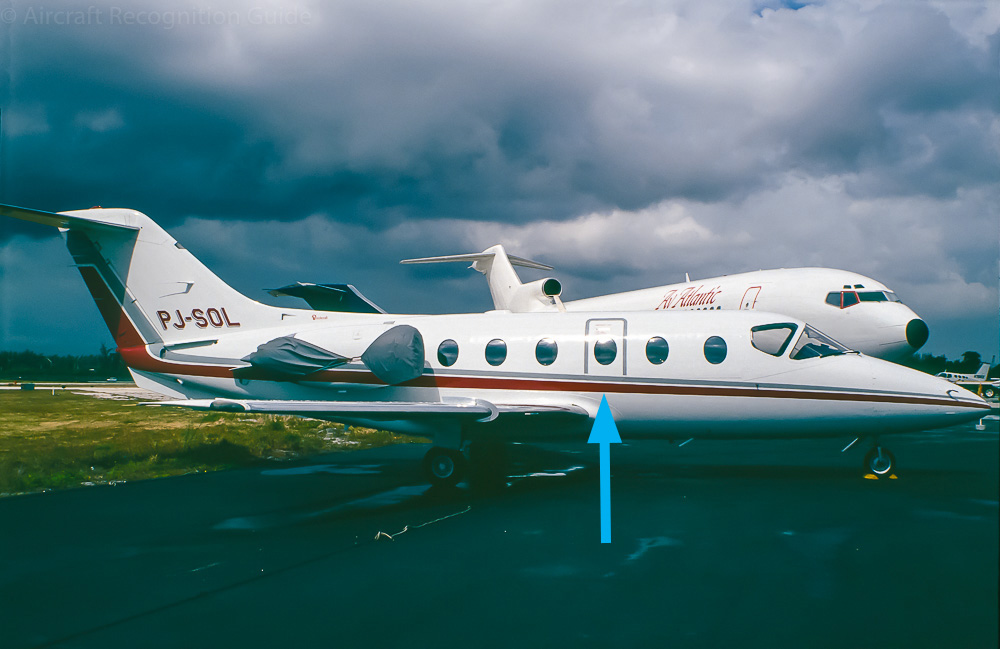
Beechcraft 400 & Mitsubishi MU-300
The Beechcraft model 400 is originally a Japanese design, i.e. the Mitsubishi MU-300 Diamond. They have a typical bizjet appearance with low mounted wings, engines attached to the rear fuselage and a T-tail. Most typical are the cockpit windows. with the frame between the front and side windows being perpendicular to the most commonly found design. Finally, the aircraft has oval cabin windows and an all single wheel landing gear.
Typical cockpit windows of MU-300 and Beech 400
Different versions
To differentiate between the subtypes you have to look at
- the number of cabin windows
- the location of the emergency exit (on the right side)
- the presence of thrust reversers
- the sizes of the nacelle cover plates
- the top of the rudder
- the presence of winglets
Mitsubishi MU-300 Diamond, Diamond I & Diamond IA
Three sub versions of the MU-300 were produced, which you (unfortunately) cannot distinguish from the later early model Beechjets. It though seems that all Beechjets have thrust reversers (except the T-1 Jayhawk), so if you see a civilian MU-300/Beech 400 without them, then you can be pretty sure that it is a MU-300 or a Nextant conversion. These nacelles have different sizes of cover plates than the Williams FJ44 powered Nextant 400XT conversions.
The differences between the Diamonds are supposed to be in the number of cabin windows, but we have not discovered them. All versions have six windows on both sides. Only internal changes have occurred and the weights are changed.
Mitsubishi MU-300-10 Diamond II & Beechcraft 400 Beechjet
This is the version of the MU-300 that Beechcraft took over and produced as Beechjet 400. All eleven Diamond IIs built were subsequently converted to Beech 400. The differences compared to the earlier Diamond versions are minimal, except that they can have thrust reversers.
Confusion possible with
Cessna CitationJet/Citation CJ series
The Cessna CitationJet and Citation CJ family has about the same size as the MU-300/Beech 400, but does not have the distinctive cockpit windows of the latter. This also applies to many other airplanes of similar size.
HFB320 Hansajet
This is the only same size airplane that has a comparable cockpit window configuration as the MU-300/Beechjet. However, the Hansajet has forward swept wings through the fuselage and tip tanks, so is totally different.
Beechcraft 400A Beechjet
A Beech 400A can easily be recognised from a Beech 400. The emergency exit, on the right side, is located at the third window at the MU-300 and Beech 400 (counted from the cockpit). The Beech 400A has it at the second window. Another difference is less clear, and you will have to look at the top of the rudder for that. The Beech 400 has a yaw damper over there, the 400A does not.
Beechcraft T-1A Jayhawk & T-400
Beechcraft made two versions of the Beech 400A as a training aircraft, the T-1A for the US Air Force and the T-400 for the Japanese air force. These are officially designated Model 400T.
The T-1A differs from its commercial counterpart by structural enhancements enable a large number of landings per flight hour, increased bird strike resistance and an additional fuselage fuel tank. On the outside it has only three cabin windows (instead of five or six) and lacks thrust reversers.
The T-400 is similar, but has four cabin windows and standard thrust reservers.
Raytheon/Hawker Beechcraft 400A Hawker 400/400XP
After Raytheon Aircraft acquired Beechcraft the marketing designation changed to Hawker 400, as Raytheon thought the aircraft would fit better in the Hawker product line. The aircraft was improved as the Hawker 400XP, which is supposed to have five windows on each side, while almost all Beechjet 400As have six windows. Like the Beech 400s and MU-300s though, so we don't count too much on this...
The Hawker 400XP is supposed to be recognised by the five cabin windows on the right side.
Beechcraft 400A Hawker 400XPR
The success of the Nextant 400XT/400XTi prompted the manufacturer to come with its own upgrade for the Beech 400A. The Hawker 400XPR is about the retrofit like Nextant Aerospace offers, so new Williams FJ44s engines and a “glass” cockpit, but then offered by the original manufacturer and including winglets! The winglets are larger than those on the Nextant 400XTi which should make it easy to recognise. Also unlike on the Nextant conversions, the Hawker 400XPRs have an external exhaust pipe. Be aware however that Clemens Aviation refurbishes Beech 400As with new avionics and Textron winglets, but without the engine change. So these upgraded aircraft are not Hawker 400XPRs!
A Hawker 400XPR with tall winglets. (photo Textron Aviation)
Nextant 400XT & 400XTi
Nextant Aerospace has developed an upgraded version of the original Beech 400A that has a significantly better performance. Called the Nextant 400XT the airplane has new Williams FJ44s engines, without thrust reversers, and a “glass” cockpit. The Nextant 400XTi is the same but has small winglets. The latter should make it easier recognisable from the other Beechjets and the Nextant 400XT, and especially the Hawker 400XPR which has larger winglets. Additionally, the cover plates of the nacelles are different.
















